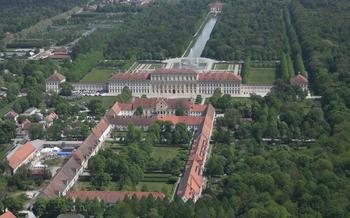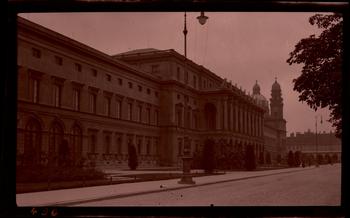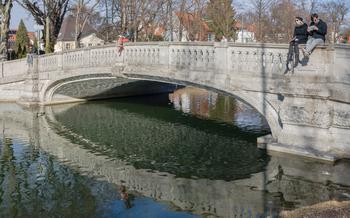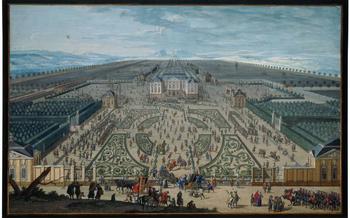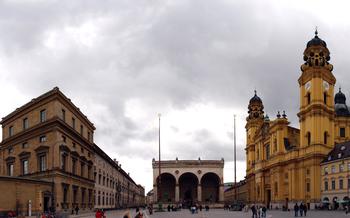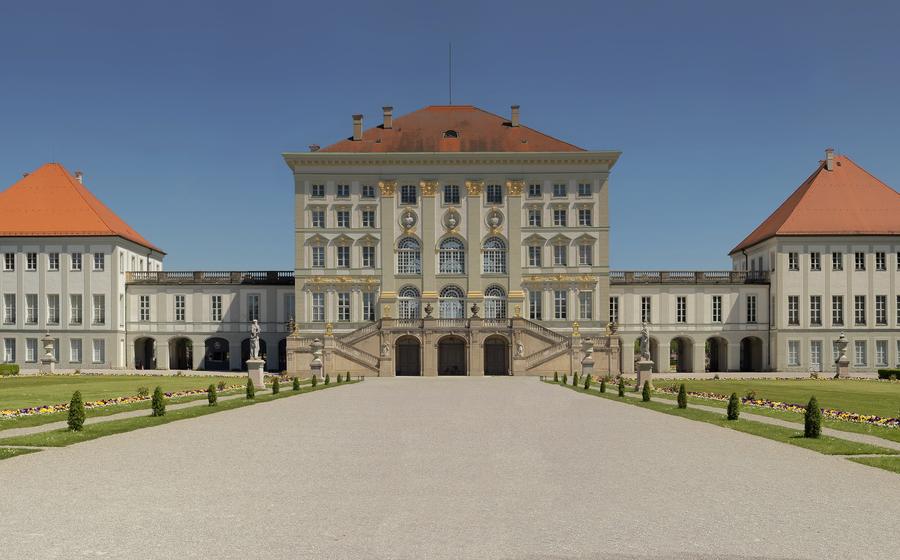
Nymphenburg Palace
- A Royal Residence
- The Grand Entrance
- The Royal Apartments
- The Palace Gardens
- The Marstallmuseum: A Tribute to Bavaria's Equestrian Heritage
- The Museum of Man and Nature
- The Botanical Garden
- The Badenburg
- The Pagodenburg: An Architectural Gem in Nymphenburg Park
- The Amalienburg: A Rococo Gem
- The Magdalenenklause: A Haven of Tranquility
- The Hubertus Chapel: A Sanctuary of Spirituality and Beauty
- The Parktheater
- The Nymphenburg Porcelain Manufactory
- Insider Tip
A Royal Residence
Nymphenburg Palace, a resplendent masterpiece of Baroque architecture, stands as a testament to the grandeur and opulence of the Bavarian monarchy. Immerse yourself in the rich history of this majestic residence, dating back to the 17th century when Elector Ferdinand Maria commissioned its construction as a summer retreat for his beloved wife, Henriette Adelaide of Savoy. Over the centuries, the palace underwent several expansions and renovations, each adding to its architectural splendor.
The palace's impressive façade, adorned with intricate carvings and statues, hints at the treasures that lie within. Step through the grand entrance and be captivated by the opulent interiors, a testament to the refined taste and extravagance of the Bavarian court. Guided tours, available in multiple languages, provide an insightful journey through the palace's grand halls and lavish chambers, offering a glimpse into the lives of the Wittelsbach dynasty.
Among the palace's many highlights, the Hall of Mirrors stands out with its breathtaking grandeur. This magnificent hall, modeled after the famous Hall of Mirrors at Versailles, boasts an array of shimmering mirrors that reflect the opulent chandeliers, creating an enchanting and awe-inspiring spectacle. The Great Gallery, with its impressive collection of paintings, offers a glimpse into the artistic patronage of the Bavarian court, showcasing masterpieces by renowned artists such as Rubens, Van Dyck, and Canaletto.
The Grand Entrance
The grand entrance to Nymphenburg Palace is a sight to behold. The imposing gates, adorned with intricate carvings and golden embellishments, welcome visitors to this magnificent royal residence. The spacious courtyards, lined with statues and fountains, create a sense of grandeur and opulence.
The majestic Königsbau (Royal Building), the heart of the palace, stands proudly at the end of the main courtyard. Its impressive façade, featuring rows of arched windows and elaborate balconies, reflects the architectural splendor of the Baroque era.
Inside the Königsbau, visitors are greeted by the Hall of Mirrors, a breathtaking sight that epitomizes the palace's grandeur. The walls are lined with floor-to-ceiling mirrors, reflecting the shimmering light from the stunning chandeliers that hang from the ornate ceiling. The Hall of Mirrors served as a grand ballroom, where lavish parties and celebrations were held by the Bavarian court.
Adjacent to the Hall of Mirrors is the Great Gallery, an equally impressive space that showcases a remarkable collection of paintings by renowned artists. The gallery's walls are adorned with masterpieces depicting historical scenes, landscapes, and portraits of the Bavarian royal family. The Great Gallery offers visitors a glimpse into the artistic patronage and cultural heritage of the Bavarian court.
The Royal Apartments
The royal apartments at Nymphenburg Palace offer a captivating glimpse into the private lives of Bavarian royalty. These opulent state rooms and private chambers are adorned with lavish furnishings, exquisite tapestries, and priceless works of art, reflecting the grandeur and extravagance of the Bavarian court.
One of the highlights of the royal apartments is the Porcelain Cabinet, a room dedicated to the display of Nymphenburg's world-renowned porcelain collection. Here, you can marvel at the delicate figurines, intricate tableware, and stunning vases that showcase the artistry and craftsmanship of the Nymphenburg Porcelain Manufactory.
Another must-see feature is the Schönheitengalerie (Gallery of Beauties), a collection of portraits depicting the most beautiful women of the Bavarian court. These life-size paintings offer a fascinating glimpse into the standards of beauty and femininity that prevailed during the 19th century.
The Palace Gardens
Amidst the hustle and bustle of Munich, the Nymphenburg Palace Gardens offer a tranquil oasis, inviting visitors to escape into a world of natural beauty and tranquility. Designed in the formal French style, the gardens are a masterpiece of landscape architecture, with intricate parterres, manicured lawns, and majestic fountains.
As you step into the gardens, you'll be greeted by the Grand Cascade, a stunning water feature that cascades down a series of terraces, creating a mesmerizing spectacle. The surrounding parterres, with their colorful floral displays, add a vibrant touch to the landscape.
Strolling along the tree-lined paths, you'll discover hidden gems like the Badenburg, a charming bathhouse with elegant architecture and opulent interiors. The Pagodenburg, a unique Chinese-style pavilion, offers panoramic views of the park from its top.
The Nymphenburg Park, which surrounds the palace, is a vast expanse of greenery, perfect for leisurely walks, picnics, or bike rides. It's home to a variety of wildlife, including ducks, geese, and squirrels, adding to the serene atmosphere.
Whether you're seeking a peaceful retreat or an opportunity to explore the natural world, the Nymphenburg Palace Gardens are a must-visit destination, offering a delightful blend of history, beauty, and tranquility.
The Marstallmuseum: A Tribute to Bavaria's Equestrian Heritage
Nestled within the sprawling grounds of Nymphenburg Palace, the Marstallmuseum stands as a testament to the rich equestrian heritage of Bavaria. Once the royal stables, this magnificent building now houses an impressive collection of horse-drawn carriages, sleighs, and harnesses that once graced the grand processions of Bavarian royalty.
Step inside the Marstallmuseum, and you'll be transported back in time to an era of elegance and opulence. Marvel at the intricate craftsmanship and lavish ornamentation of the carriages, each adorned with intricate carvings, gilded accents, and plush upholstery. From ceremonial coaches to hunting sleighs, the collection showcases the finest examples of carriage-making artistry from the 18th to the 20th centuries.
But the Marstallmuseum is more than just a showcase of royal transportation. It also offers a fascinating glimpse into the daily lives of the Bavarian court and the important role that horses played in their world. Interactive exhibits and hands-on experiences bring the history of the royal stables to life, allowing visitors to learn about the training and care of the horses, the elaborate ceremonies and processions they participated in, and the skilled artisans who crafted the magnificent carriages.
Whether you're a history buff, an equestrian enthusiast, or simply someone who appreciates fine craftsmanship, the Marstallmuseum is a must-visit attraction at Nymphenburg Palace. Immerse yourself in the world of Bavarian royalty and experience the grandeur and elegance of a bygone era.
The Museum of Man and Nature
Immerse yourself in the wonders of the natural world at the Museum of Man and Nature, located within the grounds of Nymphenburg Palace. This captivating museum takes you on a journey through the fascinating realms of biodiversity and evolution, showcasing an impressive collection of fossils, minerals, and interactive exhibits that bring science to life.
Explore the intricate connections between humans and the environment through engaging displays that highlight the diversity of life forms, from the smallest microorganisms to the majestic creatures that roam the earth. Discover the processes of evolution and adaptation, and gain insights into the delicate balance that sustains our planet.
The museum's impressive collection of fossils and minerals offers a glimpse into the earth's rich geological history. Marvel at the remains of prehistoric creatures, including dinosaurs, saber-toothed tigers, and mammoths. Learn about the formation of minerals and their significance in the earth's crust.
Enhance your visit with interactive exhibits and hands-on experiences that make learning fun and engaging for visitors of all ages. Participate in interactive quizzes, explore virtual reality environments, and witness live demonstrations that bring scientific concepts to life.
Don't miss the planetarium, where captivating shows transport you to distant galaxies, revealing the mysteries of the cosmos. Immerse yourself in stunning visuals and immersive sound effects as you journey through the vastness of space, learning about stars, planets, and the wonders of the universe.
The Botanical Garden
Nestled within the sprawling grounds of Nymphenburg Palace, the Botanical Garden is a haven for plant enthusiasts and nature lovers alike. Established in 1715, it is one of the oldest botanical gardens in Germany and boasts a diverse collection of plants from around the world.
The garden is home to over 10,000 species of plants, including exotic tropical varieties and native Bavarian flora. Visitors can wander through the various greenhouses, each dedicated to a specific climate zone, and marvel at the beauty and diversity of the plant kingdom.
The greenhouses, with their controlled temperature and humidity, provide ideal conditions for the cultivation of delicate and rare plants. Visitors can admire the vibrant orchids, towering cacti, and lush ferns, as well as a variety of medicinal and economically important plants.
Beyond the greenhouses, the garden also features outdoor display areas, where visitors can stroll among fragrant rose gardens, manicured lawns, and tranquil ponds. The educational programs and guided tours offered by the garden provide visitors with insights into the fascinating world of botany and the importance of plant conservation.
Whether you are a seasoned botanist or simply someone who appreciates the beauty of nature, the Botanical Garden at Nymphenburg Palace is a must-visit destination. Its diverse collection of plants, educational exhibits, and tranquil atmosphere make it a perfect place to learn, explore, and find inspiration.
The Badenburg
Nestled amidst the tranquil surroundings of Nymphenburg Park, the Badenburg stands as a testament to the refined bathing culture of the Bavarian court. Built in 1719 as a private bathing pavilion for Elector Max Emanuel, this charming structure boasts an intriguing history and opulent interiors.
The Badenburg's elegant architecture is a blend of Baroque and Rococo styles, featuring intricate stuccowork, graceful curves, and delicate pastel colors. Inside, visitors are greeted by a series of lavishly decorated rooms, each adorned with exquisite frescoes, tapestries, and opulent furnishings.
The Bathing Museum, housed within the Badenburg, provides a fascinating glimpse into the bathing rituals and customs of the Bavarian court. Visitors can learn about the significance of bathing in the 18th century, as well as the various bathing practices and treatments employed by the royals.
Today, the Badenburg serves as a unique and serene retreat within the bustling park. Visitors can wander through its elegant rooms, admire the intricate artwork, and soak in the tranquil atmosphere that pervades this enchanting bathhouse.
The Pagodenburg: An Architectural Gem in Nymphenburg Park
Amidst the lush greenery of the Nymphenburg Park, stands a unique architectural marvel - the Pagodenburg. This Chinese-style pavilion, built in the 18th century, is a testament to the Bavarian royal family's fascination with exotic cultures.
The Pagodenburg boasts intricate architecture, with its octagonal shape and multiple tiers. The exterior is adorned with exquisite decorations, including colorful tiles, intricate carvings, and delicate paintings. Each tier of the pagoda features unique designs, creating a visually captivating structure.
The history of the Pagodenburg is as fascinating as its architecture. It was commissioned by Elector Max III Joseph as a summer retreat and a place to entertain guests. The pavilion served as a venue for lavish parties, concerts, and theatrical performances, immersing visitors in a world of Eastern opulence and splendor.
Visitors to the Pagodenburg can climb to the top of the pagoda to enjoy panoramic views of the surrounding park and the distant Alps. The interior of the pavilion is equally impressive, with elegant rooms decorated in Chinese style. The walls are adorned with murals depicting scenes from Chinese mythology and history, creating an immersive experience for visitors.
The Pagodenburg stands as a testament to the Bavarian royal family's appreciation for cultural diversity and their desire to incorporate exotic elements into their architectural endeavors. It serves as a reminder of the cultural exchanges and influences that shaped the development of European architecture and design.
The Amalienburg: A Rococo Gem
Nestled amidst the serene landscapes of Nymphenburg Park, the Amalienburg stands as a testament to the grandeur and elegance of the Rococo era. Built as a hunting lodge for Elector Max III Joseph and his wife Amalie Auguste, this charming palace is a masterpiece of architectural artistry.
The Amalienburg's exterior boasts a delicate pink façade adorned with intricate stucco work and graceful curves, reflecting the playful and decorative style of Rococo architecture. Inside, visitors are greeted by a world of opulence and refinement. The Hall of Mirrors, with its shimmering reflections and exquisite chandeliers, is a highlight of the palace, creating a sense of grandeur and enchantment.
The state rooms are adorned with elaborate furnishings, fine tapestries, and precious artworks, showcasing the exquisite taste and lavish lifestyle of the Bavarian court. The Cabinet of Mirrors, with its collection of rare porcelain and delicate paintings, is a testament to the refined aesthetics of the era.
Surrounding the Amalienburg, the tranquil gardens provide a serene backdrop to the palace's grandeur. Visitors can stroll through the manicured lawns, admire the colorful flowerbeds, and enjoy the tranquil atmosphere of this idyllic setting.
Whether exploring its elegant interiors or wandering through its serene gardens, the Amalienburg offers a glimpse into the refined world of Bavarian royalty and the artistic legacy of the Rococo era, leaving visitors with a lasting impression of its beauty and charm.
The Magdalenenklause: A Haven of Tranquility
Nestled amidst the serene landscapes of Nymphenburg Park, the Magdalenenklause stands as a testament to the simple life and spiritual devotion. Built in 1725 by Elector Max Emanuel as a hermitage for his mistress, Magdalena von Haunsperg, this charming retreat exudes an aura of tranquility and introspection.
The Magdalenenklause is a modest structure, reflecting the humble lifestyle of its former inhabitants. Its rustic interiors are adorned with simple furnishings, creating an atmosphere of peace and contemplation. Visitors can explore the small chapel, where Magdalena sought solace and spiritual guidance, and admire the delicate frescoes depicting scenes from the life of Mary Magdalene.
Legends surround the Magdalenenklause, adding to its mystique. One tale tells of Magdalena's deep remorse for her past transgressions, leading her to seek redemption through a life of penance and prayer. Another story speaks of her profound connection with nature, finding solace in the serene surroundings of the park.
Today, the Magdalenenklause stands as a reminder of the power of simplicity and the pursuit of inner peace. Visitors can wander through its tranquil gardens, reflecting on the life of Magdalena and the lessons she imparted. The hermitage offers a respite from the bustling city, inviting visitors to embrace the tranquility of nature and reconnect with their spiritual selves.
The Hubertus Chapel: A Sanctuary of Spirituality and Beauty
Nestled amidst the serene landscapes of the Nymphenburg Palace Park, the Hubertus Chapel stands as a testament to the spiritual heritage of Bavaria. Dedicated to Saint Hubert, the patron saint of hunters, this exquisite chapel exudes an aura of tranquility and devotion.
The history of the Hubertus Chapel is intertwined with the Wittelsbach dynasty, the former rulers of Bavaria. Elector Ferdinand Maria commissioned the construction of the chapel in 1663 as a token of gratitude for surviving a hunting accident. The chapel was designed by the renowned architect Agostino Barelli, who infused the structure with a harmonious blend of Baroque and Rococo elements.
The interior of the Hubertus Chapel is a masterpiece of artistic craftsmanship. The walls and ceiling are adorned with stunning frescoes depicting scenes from the life of Saint Hubert, rendered with intricate detail and vibrant colors. The intricate woodwork, carved with precision and artistry, adds to the chapel's opulent charm.
Visitors to the Hubertus Chapel are immediately captivated by its serene atmosphere. The soft light filtering through the stained-glass windows casts a warm glow upon the interior, creating a sense of reverence and spirituality. The chapel's acoustics are equally impressive, enhancing the experience of attending mass or listening to sacred music performances held within its hallowed walls.
Whether you are a devout believer seeking solace or an art enthusiast marveling at its architectural splendor, the Hubertus Chapel offers a unique and enriching experience for all visitors. It stands as a symbol of Bavaria's rich cultural heritage and serves as a reminder of the enduring power of faith and spirituality.
The Parktheater
Nestled amidst the tranquil beauty of Nymphenburg Park, the Parktheater stands as a charming venue for cultural performances and events. Its elegant architecture, with its intricate facade and graceful lines, complements the surrounding natural splendor. Step inside and be enveloped by an intimate atmosphere, where the cozy auditorium invites you to immerse yourself in a world of art and entertainment.
The Parktheater hosts a diverse program of performances, ranging from classical concerts and theatrical productions to contemporary dance and cabaret shows. Its intimate setting fosters a unique connection between performers and audience, creating a truly immersive experience. Whether you're a seasoned theater enthusiast or simply seeking a memorable evening out, the Parktheater offers a delightful escape into the realm of performing arts.
After your visit to the Parktheater, take advantage of the opportunity to explore the surrounding park. Wander along the tranquil paths, admire the stunning gardens, and soak in the serene atmosphere that envelops this enchanting domain. The Nymphenburg Park, with its rich history and natural beauty, provides the perfect backdrop for a leisurely stroll or a relaxing picnic.
The Nymphenburg Porcelain Manufactory
The Nymphenburg Porcelain Manufactory is a world-renowned porcelain factory located within the grounds of Nymphenburg Palace. Founded in 1747 by Elector Max III Joseph, the manufactory has a rich history of producing exquisite porcelain masterpieces.
Visitors to the manufactory can learn about the intricate process of porcelain production, from the sourcing of raw materials to the firing and glazing of the finished pieces. The manufactory also houses a museum that showcases a stunning collection of porcelain masterpieces, including historical pieces, contemporary designs, and limited-edition collaborations.
One of the highlights of the manufactory is the opportunity to see the skilled artisans at work, demonstrating their mastery of traditional techniques. Visitors can also purchase unique porcelain items from the manufactory's shop, including tableware, figurines, and decorative objects.
Whether you're a porcelain enthusiast or simply appreciate fine craftsmanship, a visit to the Nymphenburg Porcelain Manufactory is a must-do experience when visiting Nymphenburg Palace.
Insider Tip
For an unforgettable experience, plan your visit to Nymphenburg Palace during the summer months when the gardens are in full bloom. The vibrant colors and fragrant scents will enhance your stroll through the park, creating a magical atmosphere. Take advantage of the combined ticket that offers admission to the palace, the Marstallmuseum, and the Museum of Man and Nature. This cost-effective option allows you to explore a variety of attractions and delve deeper into the history and culture of Nymphenburg. Don't miss the opportunity to enjoy a leisurely stroll through the beautiful Nymphenburg Park after your palace visit. Relax by the tranquil waters of the canals, admire the stunning sculptures, and soak in the serene atmosphere. Whether you're a history buff, nature lover, or art enthusiast, Nymphenburg Palace offers a captivating experience that will leave you with lasting memories.
